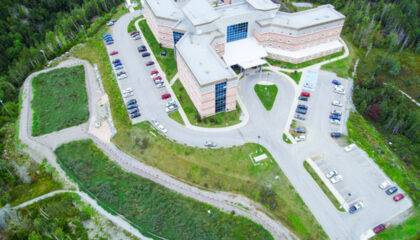The journey to net zero is one of the biggest challenges of our time. Reducing emissions, rethinking infrastructure, and creating sustainable systems that work with nature instead of against it is the path forward. And one of the most overlooked tools in this effort? Engineered Wetland systems.
While most people associate net zero strategies with solar panels, electric cars, or wind farms, the natural world has its own powerful solutions. Engineered wetlands are stepping up as quiet but effective contributors to climate goals by helping clean water, reduce emissions, capture carbon, and operate with a near-zero energy footprint.
So how do they fit into the net zero picture? Let’s break it down.
A Natural Ally in the Carbon Fight
At the core of a net zero strategy is the idea of balance—removing as much carbon from the atmosphere as we put into it. Wetland systems are natural carbon sinks. The plant life and soil microorganisms inside these systems can absorb and store carbon dioxide over time.
On top of that, these systems are designed to treat wastewater without relying on electricity-hungry equipment. That means fewer emissions from day one.
And here’s where it gets even better. By treating organic content wastewater, wetlands reduce the release of methane and nitrous oxide—two of the most potent greenhouse gases—by using aerobic processes that naturally occur in soil and plant roots.
Energy Use: Low to None
Traditional wastewater treatment facilities are often massive energy consumers. Pumps, aerators, and chemical dosing systems run around the clock to make water clean enough for discharge.
Wetland systems, on the other hand, use gravity and biology. Once built, they require little to no external power. This dramatically reduces operational emissions and helps move communities and industries closer to their net zero goals.
By lowering the energy demand of organic content wastewater treatment, these systems become a smart, cost-effective part of the climate solution.
Long-Term Sustainability Without Compromise
Here’s the thing about net zero—it’s not a short-term goal. It requires long-term planning, long-term thinking, and infrastructure that lasts.
Wetland systems are designed to operate for 75 to 100 years with minimal intervention. That means fewer replacements, less rebuilding, and a much smaller lifetime carbon footprint compared to traditional infrastructure.
The fact that these systems handle everything from organic content wastewater to stormwater and industrial effluents without relying on harmful chemicals or frequent maintenance makes them an even more sustainable option.
Built-In Biodiversity Benefits
Achieving net zero isn’t just about carbon. It’s about restoring balance to the planet—and that includes protecting biodiversity. Wetland systems offer valuable habitat for local flora and fauna, often turning wastewater treatment sites into nature preserves.
By creating green infrastructure, we’re not just offsetting emissions. We’re building ecosystems that naturally support cleaner air, healthier soil, and greater resilience against climate change.
The Offset Angle
One of the most promising parts of including wetlands in net zero strategies is their potential to generate carbon offsets. By quantifying the amount of carbon stored in plant biomass and soil, or the emissions avoided through natural treatment processes, wetlands can become credit-generating systems.
These offsets can be sold to help finance wetland construction or maintenance—or used to balance an organization’s own emissions.
This is where visionary environmental engineering comes into play. Pioneers like Glenn Sharp P. Eng of Canada have explored how engineered wetlands can generate measurable environmental returns and help fund infrastructure without creating new financial burdens.
Wetlands for Industrial and Municipal Use
Net zero isn’t just a goal for governments. Industries and municipalities are under growing pressure to reduce emissions and clean up their operations.
Wetland systems offer a versatile solution. Whether it’s a small town looking for a low-energy way to manage sewage or a facility needing to treat contaminated water, wetlands can be custom-designed to meet the need.
For example, a facility handling organic content wastewater might traditionally use high-powered aerobic digesters. By switching to a wetland system, they can achieve similar treatment levels with far less energy—and generate long-term carbon savings in the process.
Financial and Environmental Return
Sustainability often gets framed as a cost. But in the case of wetlands, the numbers can work in your favour. Because they use fewer resources and require less maintenance, operational costs are significantly lower over the life of the system.
Add in the potential for carbon credit revenue, avoided regulatory penalties, and improved community goodwill, and it becomes clear that wetlands offer value on multiple fronts.
Some of the most impactful work in this space has been led by professionals like Glenn Sharp Professional Engineer in Canada, who emphasize how natural systems can deliver both environmental integrity and economic returns.
Integrating Wetlands Into Net Zero Planning
If you’re working on a climate action plan or sustainability roadmap, consider the following:
- Identify where high-energy treatment processes can be replaced with natural systems.
- Calculate emissions reductions tied to zero-energy wetland operations.
- Explore carbon offset certification for long-term return on investment.
- Engage with experts who understand the design and regulatory landscape of natural infrastructure.
Wetlands aren’t a silver bullet, but they’re a powerful, proven tool in the toolbox. When you combine their environmental performance with their ability to support biodiversity and generate economic returns, their place in a net zero strategy becomes clear.
Conclusion
The road to net zero is complex, but it doesn’t have to be high-tech to be effective. Sometimes, the best answers have been in nature all along.
By embracing engineered wetlands as part of the solution, we’re not just treating organic content wastewater more responsibly—we’re building a future where water, air, and ecosystems work together to support life.
It’s time we let nature lead.

